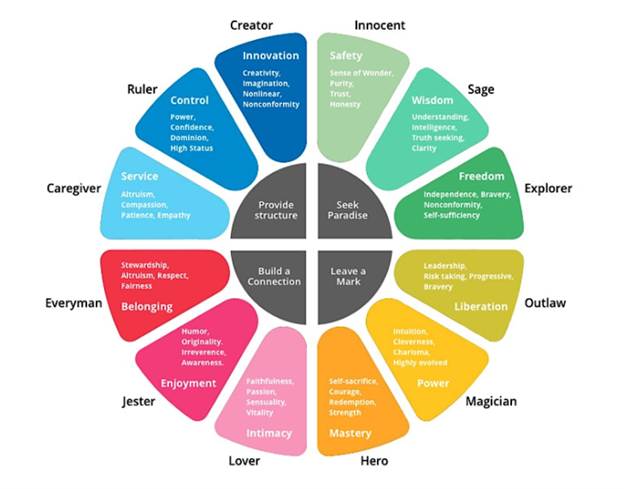How To Humanize My Brand
How is it possible for people to get so attached to some brands? Is there some scheme or tactic other brands are using? Well, the answer is yes. Even though it seems complicated for something so abstract as a brand to receive human traits, it is necessary for its mere existence.
The nature of humans is to get close to others they can relate with. The same happens with brands. It is easy for people to connect to brands relatively equal to their beliefs, actions, thoughts, interactions. Therefore, working on an archetype for your brand is essential for their success. Your brand needs to connect with customers in a long-lasting closed relationship.
What are Brand Archetypes?
Archetypes are symbols to represent a particular person or thing. This concept was developed first by Plato and later as a theory by Carl Jung. The basic idea of the theory is that humans have a natural predisposition to use symbols to understand concepts.
Jung identified twelve (12) archetypes. Afterward, marketers decided to use those archetypes to define brands. The idea of brand archetypes gives a touch of personification to the brands, making them less abstract and more approachable to people’s emotions.
How to Use Archetypes to Define a Brand?
The first step in using archetypes is to understand your brand, your target customer, the needs of customers, and the benefits of your products. Then, once you know these concepts individually and how they intertwine, define what you want your clients to feel once they see or hear your brand (what is the first thing that should come to their minds?). Now, if your business were a person, what characteristics would that person have and why? Is there a story, why the person acts a certain way, what value the person communicates to others?
Develop your character based on the 12 archetypes shown before. Give the brand archetype a story and robust emotional characteristics to relate to it.
Connecting to your customers in such an intense way takes time and commitment to consistency. To develop a profound connection with your clients, you need to be authentic, have strong convictions, and connect at a psychological level.
Which are the Brand Archetypes?
Archetypes include various characteristics, ranging elements that describe a good person from a not-so-good one. Archetypes are used to define the essence you will give your products through your marketing campaigns. Here is the list of all archetypes. Start thinking about which of these 12 archetypes is more appropriate for your brand and why? Start by considering your business’s image in the customers’ eyes and interacting with the brand.
The 12 archetypes are:

The challenge is to first discover your customer’s personality, and then connect your brand with the archetype that will best appeal to a desire in your consumers.
The Innocent
This archetype pledge is one of simplicity, touching on naivety. It focuses on the innocence of the people through elements like childhood, surprise, excitement, and guiltlessness.
Thus, It is not for brands looking for lavished images. Instead, it highlights the simplicity of their products or the pureness of the brand.
This archetype is excellent for children’s brands, baby products, organic products, or other products to strive to be good, pure, young, optimistic, straightforward, moral, romantic, and loyal.
Marketing Niche: the campaign should appeal to target honesty, simplicity, and positive thinking. Better yet, the focus of a message is based on safety and recognition.
Brand Archetype examples: Johnson & Johnson, Coca Cola, Pampers, Dove, Cottonelle, Aveeno, Whole Foods.
The industries and categories: are beauty and cosmetics products, healthy styles of life, organic and natural food, body care, and healthcare.
The brand voice: should be modest, humble, honest, and enthusiastic.
The Innocent archetype customer: is motivated by simplicity, honesty, positivity, and happiness.
The Innocent branding should not use: difficulty, negativity, decadence, and grief.
The Everyman
This archetype resembles an honest person. It focuses on a non-pretentious, relatable, relaxed, reliable audience. Therefor, it stands behind the principles of being the typical person next door who is a hard worker, with common sense, and reliable.
The best word to describe this archetype is practicality. For example, luxuries and over-the-head activities are not part of their daily life. Instead, they prefer something useful over something fancy.
This archetype represents those who value money, family, and multi-culture.
Marketing Niche: the campaign should focus on common touch, sense of belonging
Brand Archetype examples: Ford, Home Depot, Ikea, Target, Wendy’s, McCain, Tesco.
The industries and categories: are everyday apparel, homelife products, automotive, family products, and comfort food.
The brand voice is authentic, humble, and friendly.
The Everyman archetype customer is motivated by solidarity, equality, friendship, inclusion.
The Everyman branding should not use standing out, isolation, or exclusion.
The Explorer
This archetype focuses on finding new ways to progress in life. They are independent with a strong sense of the outdoors. This is, explorers, search for freedom even by evading the rules.
- Their main joy is freedom.
- They have a democratic vision and a decentralized understanding of structure.
- The explorer archetype is centered on changes through innovative vision.
- They are always open to new experiences. They are best defined as adventurous, ambitious, independent, pioneering; they are pretty much the risk-taker.
Marketing Niche: brands should use this archetype if they are going for a thrilling, risk-taking, genuine image.
Brand Archetype examples: JEEP, Red Bull, NASA, Bath & Body, The Body Shop, The North Face
The industries and categories are outdoor equipment, automotive SUV category, adventure traveling, extreme sports.
The brand voice is daring, fearless, and exciting.
The Explorer customers are driven by self-discovery, exploration, adventure, and the unknown.
The Explorer branding should not use entrapment, immobility, and cautiousness.
The Outlaw
The revel archetype! The one who disregards rule, looking for an opportunity to dismantle paradigms. This brand archetype focuses on creating something new, better. They are the perfect image of the “bandit.” It is the best model to grow loyal customers.
The message must resonate through customers’ lifestyles and beliefs. Represent the customer who breaks the rules and fights the authorities.
The best adjectives are rebellious, wild, competitor, radical.
Marketing Niche: the niche is for those interested in presenting themselves as agents of change and advocating for the most unfortunate.
Brand Archetype examples: Harley Davidson, Diesel, Virgin, MTV, Tesla
The industries and categories are automotive, alternative apparel, destruction tools, and men’s cosmetics.
The brand voice is defiant, combative, and troublesome.
The Outlaw customer is driven by transformation, autonomy, and freedom.
The Outlaw branding should not use conformism, gratification, dependence, and subordination.
The Hero
The Hero archetype represents the protective, competitor, inspire, self-confident, and transformative. The focus is to turn the brand into an inspiring story of overcome adversities.
The marketing campaign shows the achievements of full potentials, the moralist, the empowerment, the positive effect of accomplishments. The values of this archetype are based on courage, overcoming adversities, and the positive impact this cause has on others. The main idea of this archetype is to help to improve the world. The brand is presented as bold, honorable, strong, inspirational, courageous.
Marketing Niche: the idea is to present a brand to like a positive one to the world, the importance should be into solving problems and inspire others; to rise.
Brand Archetype examples: Nike, Jordan, Adidas, FedEx, AmeriCorps
The industries and categories are outdoor equipment, sportswear, emergency services.
The brand voice is brave and honest.
The Hero archetype customer is driven by growth, development, and mastery
The Hero branding should not use incapability, downfall, cowardice, and incompetence.
The Creator
The creator archetype is a visionary person who desires to create something of lasting value. This archetype is creative and imaginative with a great passion for authenticity. Likes freedom of expression to connect with the surroundings. Believe technology and creativity are the clues to enable innovation in others. They are defined as creative people with great imagination, artistic values, entrepreneurship, and nonconformists.
The Marketing Niche: products to create or develop the imagination
Brand Archetype examples: Lego, Adobe, Crayola, Adobe
The industries and categories are design, IT, arts, marketing, and creative writing.
The brand voice is motivating, slightly provoking, and enthusiastic.
The Creator customers are driven by vision, creativity, innovation, and expressiveness.
The Creator branding should not use familiarity and inertia.
The Ruler
The ruler archetype seeks to control. They’re focused on making the rules. They are not the cheater kind; they like to play fair and with respect but with power as inspiration. Their goal is to foster stability, control, and create order from chaos. They can give the appearance of arrogance, but that is not the intention. They are outstanding leaders, organized, role models, and good administrators.
Marketing Niche: The ruler is interested in helping people get organized and stable. It is excellent for upscale brands, watches, luxury.
Brand Archetype examples: Rolls Royce, American Express, Microsoft, Barclays, Louis Vuitton, Rolex
The industries and categories are products related to prestige and luxury.
The brand voice is refined, commanding, and articulate.
The Ruler customers are driven by power, prosperity, status, and success.
The Ruler branding should not use failure, poverty, or insignificance.
The Magician
The magician archetype is the dreamer, the one who believes that all dreams can come true. They make problems disappear through amazing acts. This archetype is seen as a visionary, innovator, and charismatic leader who creates something unique.
Marketing Niche: to help solve problems through magical moments that others see as impossible.
Brand Archetype examples: Dyson, Sony, MasterCard, Disney, Universal, Oil of Olay.
The industries and categories are entertainment, beauty, well-being, and health.
The brand voice is mysterious and reassuring.
The Magician customers are driven by change, imagination, belief, discovery, and developing a dream to live by.
The Magician branding should not stagnation, consequences, and doubt.
The Lover
The lover archetype focuses on being in love with people, work, experiences, or the surroundings. It focuses on seducing, loving, or romance. The lover archetype can be identified as the suitable partner, the matchmaker, passionate, sensual, idealistic, the spouse, the enthusiastic. They can also relate to spiritual and family relationships.
Marketing Niche: aims to make people feel appreciated and connected.
It also corresponds to intimacy, enjoyment, and relationships.
Brand Archetype examples: Victoria Secret, Channel, Alfa Romeo, eHarmony, Magnum
The industries and categories are fashion, particularly haute couture, perfumes, cosmetics, wine, imported cars, and exotic travel.
The brand voice is pleasing, comforting, and empathetic.
The Lover customers are driven by desire, love, passion, and indulgence.
The Lover branding should not use disgrace, invisibility, or refusal.
The Jester
The Jester archetype is happy, undoubtedly, the joker, the clown. They are interested in having fun, not in following the rules.
They think outside of the box, making them great innovators. In other words, they live life to the fullest. They bring joy to the world. They have a great sense of humor, mischievous and irreverent. These brands are optimistic.
Marketing Niche: They like to make people happy and have a good time. They let others act spontaneously. They target those young at heart and inner child.
Brand Archetype examples: Budweiser, Cadbury’s, Ben & Jerry, IKEA, M&M’s.
The industries and categories are confectionary services, child services, beverage industry,
The brand voice is playful, optimistic, and fun-loving.
The Jester customers are driven by laughter, happiness, fun, and positivity.
The Jester branding should not use boredom, sadness, gloom, negativity.
The Caregiver
This archetype is driven by care and protection. They care about making people feel good. They defend the less privileged, are trustworthy, altruistic people. They have a caring mentality with a selfless personality who reacts to other people’s difficulties. They are interested in helping those vulnerable and sensitive.
Marketing Niche: focus on people whose profession is to care for others or serve the public as health professionals, those in education, aid programs, or any other person related to managing or saving people.
Brand Archetype examples: Johnson & Johnson, Unicef, WWF, Tom’s shoes, Campbell’s Soup, Heinz, NSPCC, Ronald McDonald.
The industries and categories are hospitals and medicine, education, nonprofits and charity appeals, and environmental organizations.
The brand voice is caring, empathetic, and encouraging.
The Caregiver customers are driven by help, assistance, care, appreciation, and placing others before themselves.
The Caregiver should not use ingratitude, guilt, helplessness, and distress.
The Sage
The seeker of truth. They believe the truth will set you free. They have a driven desire to know the truth and share knowledge of their findings. This archetype is compromised with rich vocabulary and researched information. They reject ignorance and misleading information. They are wealthy for trusted sources of information, wisdom, and analytic mentoring. They are great advisors of new information.
Marketing Niche: they are profoundly compromised in helping understand concepts.
Brand Archetype examples: PBS, TED, Discovery Channel, National Geographic, Googles
The industries and categories are education, media and news outlets, schools and universities, and search engines.
The brand voice is leading, educated, and well-informed.
The Sage customers are driven by intelligence, expertise, enlightenment, information.
The Sage branding should not use misinformation, imprecision, or ignorance.
The importance of all these archetypes if discerning the correct one for your brand. It is an excellent exercise to describe the traces of your brand. Make a list defining your brand and products’ strong points to the customers.
This is why archetypes work so amazingly well
Archetypes are general patterns of behavior that we all naturally understand. They are shown in stories, art, religion, and myths.
When you look more closely at these characters and their behavior, you will probably see yourself, your family, and your friends.
You will see these classic characters repeatedly, whether it’s your funny uncle acting like The Jester at your grandmother’s birthday party or your anti-establishment friend dropping conspiracy theories in the pub as The Outlaw.
Even though you already know how your uncle and friend act, you will also be able to recognize the behavior or models of people you don’t know.
Why? Because they have already been put into your mind.
Images of the inner mind
When we see this behavior, we don’t instantly think of a model figure, but it feels like something we know.
Because we instinctively understand these images, we can quickly connect with (or avoid) other people when we see them.
Because our brains are already set up to recognize these things, they are a great way to define the position of your brand and the personality traits that will connect with your target audience.
The archetypal idea of Carl Jung
I don’t like to use superlatives, but as the headline says, it’s like a hack into your audience’s mind.
Any brand that wants more than just business connections with its audience needs to work with characters. It’s an easy choice.
Conclusion
Brand archetypes help firms connect with consumers emotionally. They construct a brand story that connects with customers by delving into their subconscious and personalizing it with widely known characters and tales.
Each archetype has its own personality, from The Innocent’s idealism to The Outlaw’s defiance, from The Sage’s wisdom to The Jester’s merriment. These archetypes may give a brand a strong, lasting identity in a crowded market if used consistently and truthfully.
Consumers are increasingly choosing companies that provide more than a product or service in a world of options. They choose businesses that share their beliefs, provoke powerful emotions, and provide an immersive experience. Brand archetypes may help firms build loyal, passionate consumers.
Archetypes humanize companies, connecting businesses and customers and elevating marketing techniques to generate powerful, lasting brand stories. Understanding and using brand archetypes is a means to establish a brand that is approachable, memorable, and deeply engaging.


